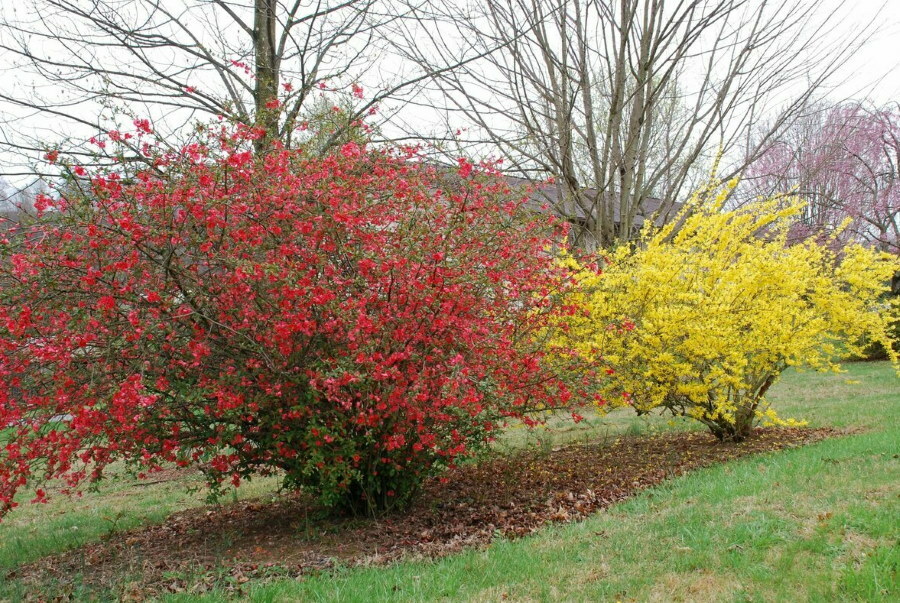Among the variety of flowering shrubs, it is not easy to single out favorites. However, there is one amazing plant that will impress even a sophisticated gardener. This is the Japanese quince (henomeles).

Japanese quince is a low-growing deciduous shrub that reaches a height of 3 meters in its homeland - in the countries of Southeast Asia. In the northern regions, the bush is much lower
Japanese quince - the use of a shrub in landscape design
Content
- Japanese quince - the use of a shrub in landscape design
- Reproduction of Japanese quince seeds and cuttings
- Seeds
- Cuttings
- Growing Japanese quince: planting and care
- Varieties and hybrids of quince for suburban cultivation
- Quince Mauley
- Quince beautiful
- Henomeles katayansky
- Zubutlinskaya quince
- Lady Pink
- Crimson and Gold
- Video: Planting and caring for Japanese quince
- Photo of the design of the site with Japanese quince
Chaenomeles is a plant that is great for landscaping. Let's consider several options for its use:
- in hedges;
- as a soloist against a background of green grass;
- in group plantings, especially in combination with plant varieties, the flowers of which have different colors;
- can be grown together with spring bulbs (muscari, tulips, daffodils, etc.);
- Japanese quince can be planted as a shrub or small tree;
- especially suitable for gardens made in Japanese or Chinese style;
- goes well with conifers and spring-flowering shrubs (kerria, spiraea, forsythia, etc.).

The spring flowering of quince is simply breathtaking

Japanese quince tolerates haircut well

In warm climates, quince can be grown in pots
Spring flowering shrubs undoubtedly bring a special joy after gray winter days in any garden area. Thanks to henomeles, it will turn into a fabulous corner and become a reminder of distant Japan.

Luxurious, bright pink flowers appear on quince branches even before the leaves are completely blooming.
In autumn, the plant bears fruits that are very useful and are often used for preparing food and drinks.

Quince fruits contain a large amount of vitamin C, the taste is rather sour

Japanese quince jam is often used to prevent colds.
Reproduction of Japanese quince seeds and cuttings
It is not difficult to propagate Japanese quince on your own. To do this, you can use one of four methods: seeds, cuttings, layering and division. Let's consider the first two as the simplest ones.
Seeds
More often quince is propagated by sowing seeds. You can collect them yourself. During the processing of ripe fruits, seeds are extracted from the core. The most favorable time for sowing them is autumn. If for some reason this could not be done, then you can sow in the spring. Only in this case, the seeds must be stratified for 2-3 months. You will need a container filled with a layer of damp earth or sand, on which you need to put the seeds. From above, they are also sprinkled with moistened soil. The container is covered with foil; there must be holes for air circulation. The chosen storage place should be cool, the air temperature should be from 0 to +3.

Seeds are hidden inside the lemon-yellow fruit - one of the ways of reproduction of quince
In spring, the seeds are planted in open ground, the depth of the holes is 1.5-2 cm. For 1 sq.m. 4 grams of seeds will be enough. As soon as two real leaves grow, they are necessarily thinned out at a distance of 7 cm from each other. After 2 years, the seedlings are pruned, then they are transplanted to the place where they will grow constantly.

Growing quince from seeds is a rather lengthy process.
This method of propagation does not always allow preserving the maternal varietal characteristics. The most suitable for this will be vegetative propagation methods.
Cuttings
You can also propagate chaenomeles with green cuttings. Towards the end of June, young, not lignified shoots are taken from the best bushes. Then they are cut into cuttings 5-7 cm long (the upper part does not fit). Cuttings are planted in pre-mixed peat with sand, on top of which sand is laid in a layer of 3 cm. The distance between the cuttings should not be less than 5 cm.

Japanese quince cuttings scheme
Then they are placed in plastic greenhouses, you can simply cover them with plastic. It is necessary to spray the planted cuttings with water several times a day.

In a warm place, quince cuttings take root within 4-6 weeks
It is necessary to ensure that the leaves do not dry out, but are always wet.
Growing Japanese quince: planting and care
Before planting quince, you need to find a place and prepare the soil. The plant is thermophilic, therefore it should be planted in a sunny place. In a shady place, the shrub may not bloom at all. It will be a great advantage if snow accumulates in the place chosen for planting the plant. It will protect the chaenomeles from frost. Like many plants, Japanese quince does not like stagnant water.
The most suitable soil for quince is light, fertile, sandy loam or loamy, sod-podzolic, moist. Alkalization of the soil can lead to the development of chlorosis.

Saplings for planting quince on your site are best purchased at a local nursery
The most suitable option would be one or two year old seedlings. It is recommended to plant in the first half of spring, when the buds have not yet blossomed. Some are planted in the fall, but it is better to do this at least a month before the onset of cold weather. The planted plants must be spud.
Before planting, it is necessary to prepare the soil from leafy earth, sand and peat compost (2: 1: 2). You can use fertilizers, for example, add 30 grams of potassium nitrate, superphosphate - 200 grams, as well as 10 kg of compost or humus to the hole. Mix everything thoroughly with the soil and let the soil mixture stand for a while. It is recommended to prepare the planting site in the fall, and plant the seedlings in the spring.

Planting pit scheme for Japanese quince
The size of the planting pit should be approximately 50x50x50 cm, each of them should be at a distance of 1 m from each other. If this condition is not met, air circulation will be disrupted, and this can cause plant disease.
The root collar of a young seedling should remain on the surface of the soil. The ground around the planted plant is compacted, and it must also be watered.
Transplanting Japanese quince is not recommended, since the plant has a long taproot, which is difficult not to injure.

Japanese quince can grow in one place for more than 50 years
Quince does not require special care, so even a novice gardener can easily cope with this. Let's learn about the intricacies of this process:
- Watering. During planting, it is necessary to water abundantly with water, then once a month is enough (to be guided by the weather).
- Top dressing. Caring for a quince bush also means regular feeding. In the spring, nitrogen-containing fertilizers are chosen. In the summer, when the flowering ends, and in the fall, as the fruits are harvested, they take potassium-phosphorus fertilizers in liquid form.

The decorative qualities and fruiting of the Japanese quince largely depend on correct watering and timely fertilizing.
- Loosening and weeding. It is important to constantly remove weeds, as well as to loosen the soil regularly. The ground around the trunk is mulched with peat, sawdust or tree bark (the layer should be at least 5 cm).
- Pruning. Like other shrubs, pruning in Japanese quince is formative and sanitary. The latter is carried out every spring and consists in getting rid of sick, dry and underdeveloped branches. Formative pruning is required by a plant over 5 years old. The best time for this is early spring. But the autumn pruning can provoke freezing of the shoots. To do everything right, you need to take into account that the most valuable branches grow in the middle of the bush upwards at an angle. Vertical and horizontal shoots are removed. For good flowering, there should be 10-15 branches of different ages and they must be healthy.

Scheme of formative pruning of quince
- Wintering. In order for chaenomeles to be reliably protected from cold weather and wind, it is surrounded by spruce branches (spruce branches). Young cuttings and seedlings can be covered with agrofibre; a box or cardboard box is also suitable.

To protect the young seedling from frost, a frame is installed and a non-woven material is stretched, which ensures air permeability of the shelter
- Diseases and pests. Chaenomeles practically does not get sick, provided that he is properly cared for. Abundant and prolonged precipitation can cause fungal diseases. For preventive purposes, the shrub must be sprayed with a foundationol solution. This must be done before it blooms.

Quince can become susceptible to fungal infections if over-watered or during the rainy season.
Varieties and hybrids of quince for suburban cultivation
Consider the main varieties that are popular.

Hundreds of species of quince are known, but due to climatic conditions in our country, only a few varieties have become widespread.
Quince Mauley
Another name for this species is “low quince”. The height of the shrub is never higher than 1.5 m. The color of young leaves is reddish-bronze, then they turn green. The flowers blooming in spring have a bright orange-red hue.

The variety has taken root well in Central Russia, tolerates moderately low frosts well
Quince beautiful
The height of the bush can reach 3 m. Quite an unusual view, since the leaves of the bush are constantly changing their color. If at first they are green, then they turn red, and by autumn they completely acquire a crimson color.

Currently, many decorative varieties of beautiful quince with flowers of pink, white, raspberry and lilac shades have been bred
Henomeles katayansky
If at first the bush is small, then over time it grows up to 3 m. Purple spring leaves become bright green in summer. The shade of the buds is pink or white.

Henomeles Katajanski is able to decorate the facade of any building with its flowers
Zubutlinskaya quince
This type of plant perfectly tolerates frost and is resistant to many diseases. Large fruits are characteristic, from which even jam or juice is made.

A folk variety of Dagestan, distinguished by very large fruits weighing 300-800 grams
Lady Pink
Beautiful frost-resistant ornamental shrub. The emergence of this species became possible thanks to the hard work of breeders. The bud has a bright pink color and yellow stamens, from which fruits similar to apples later appear.

Every spring you can observe the amazing flowering of the shrub, which can last 2-3 weeks
Crimson and Gold
One of the most beautiful types of Japanese quince. The color of the buds is bright red, and the stamens have a bright yellow tint. Basically, gardeners planted this species as a living border.

Bright voluminous flowers of unique beauty
Video: Planting and caring for Japanese quince
Photo of the design of the site with Japanese quince
Japanese quince is a shrub, a photo of the flowers of which can be seen below:
Below in the photo you can see what a Chinese quince looks like:




